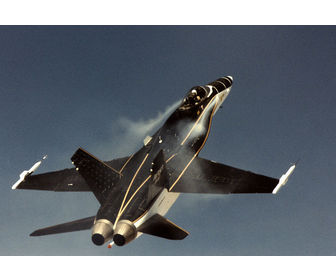High Alpha Research Vehicle

The High Alpha Research Vehicle was a modified F-A-18 Hornet used by NASA in a 3-phase program investigating controlled flight at high angles of attack using thrust vectoring modifications to the flight controls and with actuated forebody strakes. The program lasted from April 1987 to September 1996. NASA reported that in one phase of the project Dryden Flight Research Center research pilots Bill Dana and Ed Schneider completed the envelope expansion flights in February 1992.
F/A-18 High Alpha Research Vehicle or "HARV" during March of
1995, conducting spin testing and the first successful
excitation of the Hornet 1
Single-seat High Alpha Research Vehicle for NASA.2
Dryden’s F/A-18 High Alpha Research Vehicle or “HARV” during March of
1995, conducting spin testing and the first successful excitation of
the Hornet Falling Leaf out of control mode during flight test.3
The High Alpha Research Vehicle (HARV) is a modified McDonnell
Douglas/ Northrop F/A-18 Hornet used by NASA for research at high
angles of attack using thrust vectoring in the early 1990’s.4
Made by McDonnell DouglasNorthrop Corporation.
It is the successor of the McDonnell Douglas F-A-18 Hornet .
Single-seat High Alpha Research Vehicle for NASA.5
F-18 High Alpha Research Vehicle (HARV)took the AOA to 70
degrees as against 58 degrees said by you.6
The F-18 High Alpha Research Vehicle was used to validate computer
codes and wind tunnel research about airflow phenomena at high angles
of attack and is expected to lead to better 7
Developed From
McDonnell Douglas F-A-18 Hornet
Predecessor
McDonnell Douglas F-A-18 Hornet
Category
Manufacturer
Related
*F-A-18 Hornet
Primary user
See Also
*List of experimental aircraft*List of military aircraft of the United States
